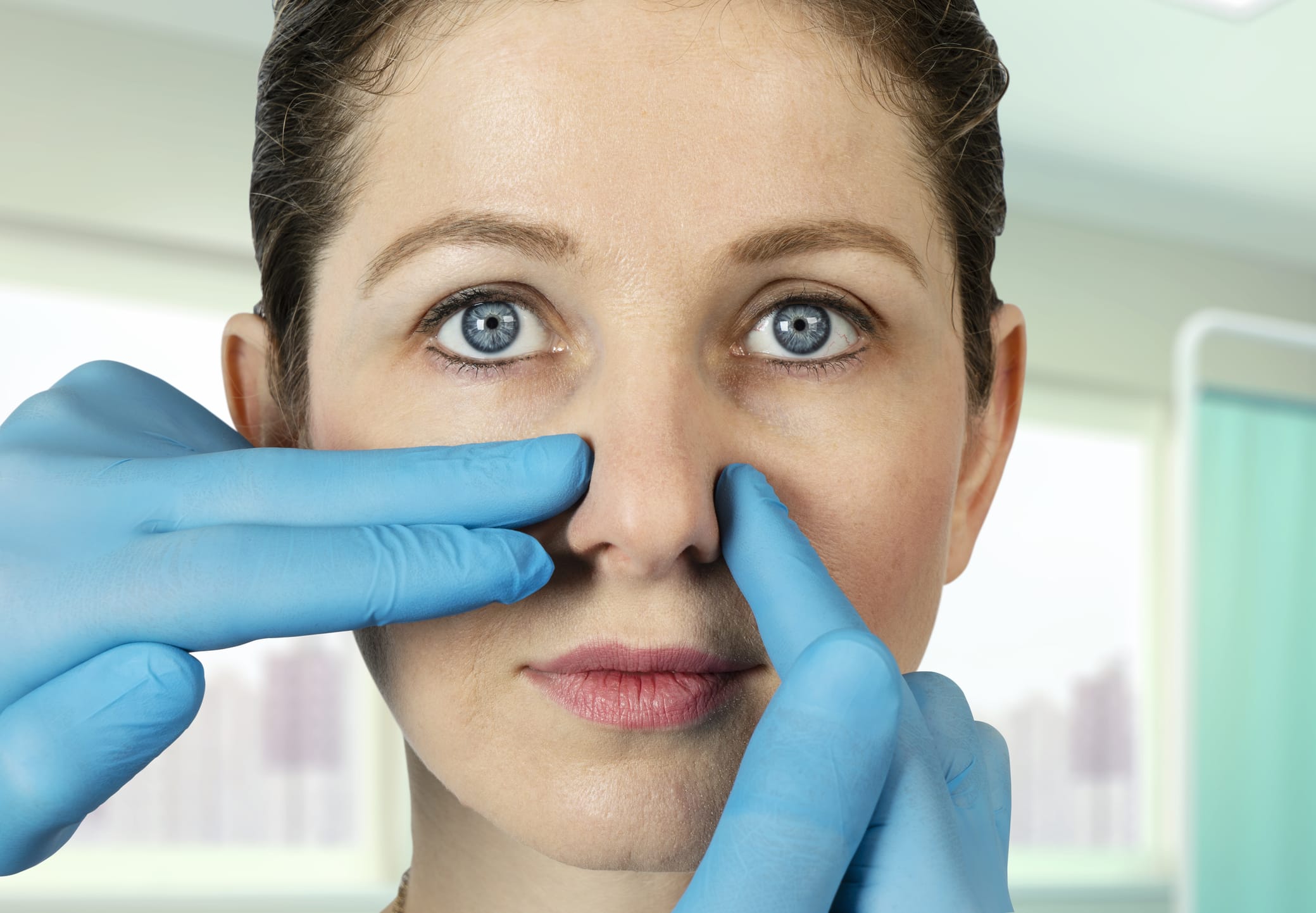(Secondary Rhinoplasty)
Comprehensive Article on Revision Rhinoplasty

Comprehensive Article on Revision Rhinoplasty (Secondary Rhinoplasty)
Introduction
Revision rhinoplasty, or secondary rhinoplasty, is one of the most complex and sensitive nasal surgeries, performed to correct unsatisfactory results from previous nose surgeries. In many cases, patients may experience issues such as dissatisfaction with the appearance of the nose or functional problems like breathing difficulties after their first nose surgery (primary rhinoplasty). In such cases, revision rhinoplasty is carried out to improve the appearance and function of the nose and address the deficiencies. This article provides a comprehensive review of revision rhinoplasty, including the reasons for the surgery, surgical methods, benefits and drawbacks, post-operative care, and expectations.
Reasons for Revision Rhinoplasty
Revision rhinoplasty is performed for various reasons, which are discussed in this section:
- Dissatisfaction with Appearance
One of the most common reasons for revision rhinoplasty is dissatisfaction with the nose’s appearance after the primary surgery. The patient may not be happy with the shape or size of their nose, or the nose may not meet their expectations. Problems such as a nose that is too small or large, a drooping or asymmetrical nasal tip, or overall disproportion of the nose compared to other facial features are common sources of dissatisfaction. - Breathing Problems
Some patients may experience breathing difficulties after the initial surgery. These problems are usually due to incorrect adjustments to the internal nasal structure, including a deviated nasal septum or excessive narrowing of the nasal airways. Revision rhinoplasty helps improve breathing function and resolves issues caused by the previous surgery. - Complications from the Initial Surgery
In some cases, patients may encounter side effects such as bleeding, infection, improper wound healing, or visible scars after the primary surgery. These complications may require correction, and revision rhinoplasty can help reduce or eliminate these problems. - Repairing Structural Damage
Some individuals may face structural issues in the nose following the primary surgery. These problems include loss of cartilage, collapse of the nasal walls, or unwanted changes in the nasal septum, which require repair and reconstruction.
Revision Rhinoplasty Surgical Methods
Revision rhinoplasty is more complex than primary surgery and requires specific techniques and skills. In this section, two main surgical methods for revision rhinoplasty are explained:
- Open Rhinoplasty
Open rhinoplasty is one of the most common methods for revision rhinoplasty. In this approach, the surgeon makes a small incision in the columella (the area between the nostrils) to access the internal structure of the nose. This method allows the surgeon full access to the cartilage, bone, and other nasal structures to make the necessary changes.
Open rhinoplasty gives the surgeon greater visibility, making it especially useful for more complex surgeries, such as correcting structural issues and reconstructing the nasal cartilage. This technique also allows the surgeon to more precisely address issues like nasal tip drooping or asymmetry.
- Closed Rhinoplasty
In the closed rhinoplasty method, all incisions are made inside the nostrils, with no external incisions on the nose’s surface. This method is suitable for cases that require smaller, less invasive changes. Closed rhinoplasty is typically used for minor corrections and resolving small issues. Due to its shorter recovery period and lack of external scars, it can be an attractive option for some patients.
However, because the surgeon has less visibility, this method is less commonly used for more complex revision surgeries that require extensive changes.
Advantages and Disadvantages of Revision Rhinoplasty
Like any cosmetic surgery, revision rhinoplasty has its own specific advantages and disadvantages, which are explored below:
Advantages
- Improved Appearance: One of the most significant advantages of revision rhinoplasty is improving the nose’s appearance. This surgery can correct aesthetic imperfections from the primary surgery and give the patient a more natural and balanced look.
- Improved Breathing Function: Revision rhinoplasty can enhance breathing function. Many patients may experience breathing problems after the primary surgery, which revision rhinoplasty can resolve.
- Increased Confidence: Many patients feel better about their appearance and nasal function after revision rhinoplasty. These positive changes can significantly boost confidence and improve their quality of life.
- Correction of Structural Problems: Revision rhinoplasty can help reconstruct and correct structural issues in the nose. This surgery is especially beneficial for patients who face structural problems such as nasal tip drooping or cartilage loss after the primary surgery.
Disadvantages
- Greater Surgical Complexity: Revision rhinoplasty is usually more complex than primary surgery and requires a highly skilled and experienced surgeon. This complexity can make the surgery longer and more challenging.
- Longer Recovery Period: Due to the increased complexity and more extensive changes in revision rhinoplasty, the recovery period may be longer. Patients must be patient and pay special attention to post-operative care.
- Higher Risk of Complications: Due to multiple corrections in revision rhinoplasty, there may be a higher risk of complications. These complications include prolonged swelling, recurrent asymmetry, or problems with wound healing.
- Need for Additional Resources (Cartilage or Skin): In some cases, the surgeon may need to use additional resources, such as cartilage harvested from other parts of the body (e.g., ear or rib) for nasal reconstruction. This can add to the complexity of the surgery and extend the recovery period.
Post-Operative Care for Revision Rhinoplasty
Post-operative care after revision rhinoplasty is crucial and can significantly affect the final results of the surgery. Below are some key post-operative care guidelines:
- Use of Cold Compresses: In the initial days after the surgery, using cold compresses helps reduce swelling and bruising. This should be done regularly and carefully to promote faster recovery.
- Avoiding Strenuous Activities: After revision rhinoplasty, patients should avoid strenuous physical activities and intense exercise. Activities that increase blood pressure may cause bleeding or increased swelling.
- Sleeping with the Head Elevated: To reduce swelling and avoid pressure on the nose, patients are advised to keep their head elevated above their body with the help of several pillows while sleeping.
- Regular Doctor Visits: Regular follow-up visits with the doctor after surgery are essential to ensure proper healing and prevent potential complications.
- Avoid Smoking and Alcohol Consumption: Smoking and alcohol can significantly slow the healing process and increase the risk of infection. Patients are advised to avoid these substances for at least several weeks after surgery.
Results and Expectations
The final results of revision rhinoplasty may take several months to fully appear. Patients should have realistic expectations of the surgery and keep in mind that full recovery may take time. The final outcome depends on the extent of the changes made, the condition of the nose before surgery, and the surgeon’s skill.
Conclusion
Revision rhinoplasty is a complex and precise surgery performed to correct deficiencies and problems that arose from the initial surgery. This procedure can improve both the appearance and function of the nose and enhance the patient’s quality of life. However, patients should have realistic expectations regarding the results and pay special attention to post-operative care to achieve the best outcomes. Selecting a skilled and experienced surgeon is also a crucial factor in the success of this surgery.


comment